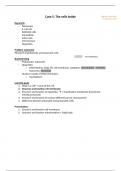Case 5: The cells inside BBS1001 2023/2024
19 september 2023
Keywords
- Nanoscopy
- E. coli cell
- Epithelial cells
- Intracellular
- Colon cells
- Cell structure
- Organelles
Problem statement
Structure of prokaryotic and eukaryotic cells
No membrane
Brainstorming
- Prokaryotic/ eukaryotic
- Organelles:
o Mitochondria, Golgi, ER, cell membrane, cytoplasm, microtubules, centrioles,
lysosomes, ribosomes
- Nucleus consists of DNA/chromatins.
o Nucleoplasm
Learning goals
1. What is a cell? + parts of the cell.
2. Structure and function cell membrane.
3. Structure and function of organelles. + classification (membrane bound/non-
membrane bound)
4. Structure and function of nucleus (different part of chromosome)
5. Difference between eukaryotic and prokaryotic cells.
Presentation:
1. Structure and function cell membrane.
2. Structure and function mitochondrion + Golgi body.
, Case 5: The cells inside
1. What is a cell? + parts of the cell.
A cell is the smallest living organism and the basic unit of life on earth. The body contains
around 50-100 trillion cells, and they vary widely in size, number, structure, and use.
They provide structure for the body, take in nutrients from food, convert those nutrients
into energy, and carry out specialized functions. Cells also contain the body’s hereditary
material and can make copies of themselves.
Cells consists of many organelles, each with a different function.
Cell has three parts: the membrane, the nucleus, and the cytoplasm.
The cytoplasm
One major component of the cytoplasm is the gel-like Cytosol, a water-based solution that
contains ions, small molecules, and macromolecules. In eukaryotes, the cytoplasm also
includes membrane-bound organelles, which are suspended in the cytosol. The
cytoskeleton, a network of fibers that supports the cell and gives it shape, is also part of the
cytoplasm and helps to organize cellular components.
Even though the cytosol is mostly water, it has a semi-solid, Jello-like consistency because of
the many proteins suspended in it. The cytosol contains a rich broth of macromolecules and
smaller organic molecules, including glucose and other simple sugars, polysaccharides,
amino acids, nucleic acids, and fatty acids. Ions of sodium, potassium, calcium, and other
elements are also found in the cytosol. Many metabolic reactions, including protein
synthesis, take place in this part of the cell.
2. Structure and function cell membrane.
Both prokaryotic and eukaryotic cells have a cell membrane, a double layer of lipids that
separates the cell interior from the outside environment. This double layer consists largely
of specialized lipids called phospholipids.
A phospholipid is made up of a hydrophilic, water-loving, phosphate head, along with two
hydrophobic, water-fearing, fatty acid tails. Phospholipids spontaneously arrange
themselves in a double-layered structure with their hydrophobic tails pointing inward and
their hydrophilic heads facing outward. This energetically favorable two-layer structure,
called a phospholipid bilayer, is found in many biological membranes.
Proteins are also an important component of the cell membrane. Some of them pass all the
way through the membrane, serving as channels or signal receptors, while others are just
attached at the edge. Different types of lipids, such as cholesterol, may also be found in the
cell membrane and affect its fluidity.
The cell membrane is the border between the interior and exterior of a cell. As such, it
controls passage of various molecules - including sugars, amino acids, ions, and water - into
and out of the cell. How easily these molecules can cross the membrane depends on their
size and polarity. Some small, nonpolar molecules, such as oxygen, can pass directly through
the phospholipid portion of the membrane. Larger and more polar, hydrophilic, molecules,
such as amino acids, must instead cross the membrane by way of protein channels, a
process that is often regulated by the cell.
The surface area of the plasma membrane limits the exchange of materials between a cell
and its environment. Some cells are specialized in the exchange of wastes or nutrients and
have modifications to increase the area of the cell membrane. For instance, the membranes




